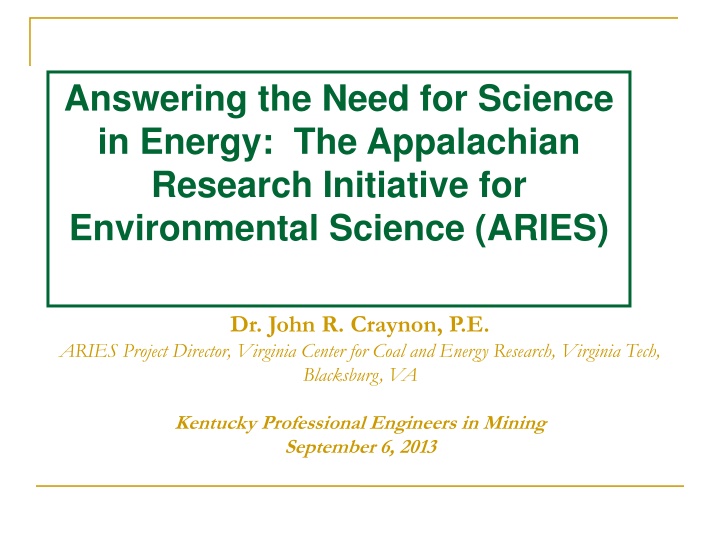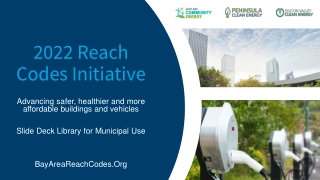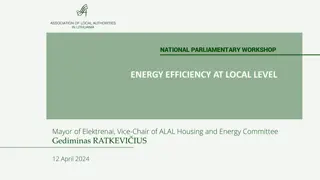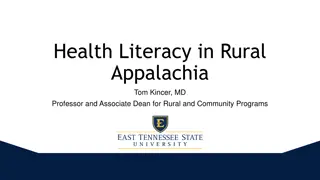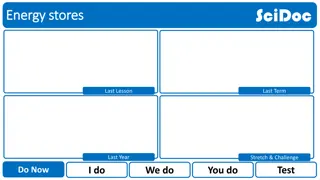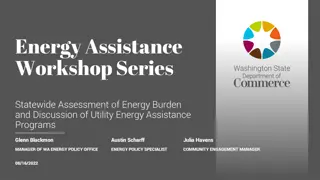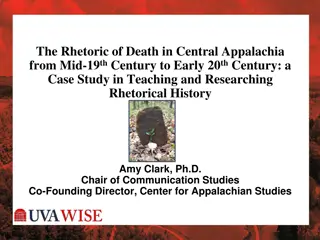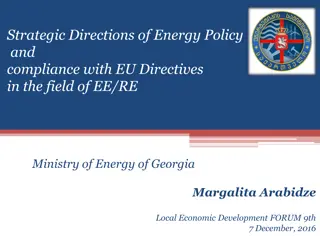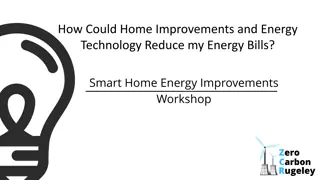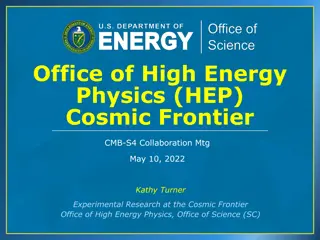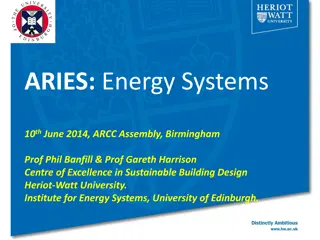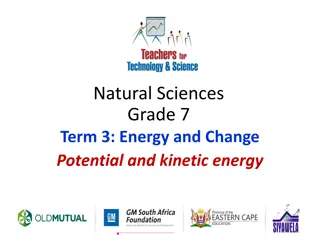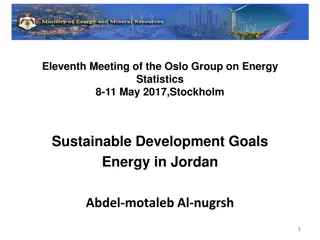Advancing Energy Research in Appalachia through ARIES Initiative
The Appalachian Research Initiative for Environmental Science (ARIES) led by Dr. John R. Craynon emphasizes the importance of science-based approaches in energy projects. ARIES focuses on areas like coal mining, natural gas, electricity generation, and renewables, with a strong emphasis on coal mining. It is funded by major companies and involves partnerships with universities to conduct research for sustainable energy production. Political and self-serving agendas in energy policies are cautioned against in favor of science-based solutions.
Download Presentation

Please find below an Image/Link to download the presentation.
The content on the website is provided AS IS for your information and personal use only. It may not be sold, licensed, or shared on other websites without obtaining consent from the author.If you encounter any issues during the download, it is possible that the publisher has removed the file from their server.
You are allowed to download the files provided on this website for personal or commercial use, subject to the condition that they are used lawfully. All files are the property of their respective owners.
The content on the website is provided AS IS for your information and personal use only. It may not be sold, licensed, or shared on other websites without obtaining consent from the author.
E N D
Presentation Transcript
Answering the Need for Science in Energy: The Appalachian Research Initiative for Environmental Science (ARIES) Dr. John R. Craynon, P.E. ARIES Project Director, Virginia Center for Coal and Energy Research, Virginia Tech, Blacksburg, VA Kentucky Professional Engineers in Mining September 6, 2013
Why do we need science-based approaches? Most issues and problems have scientific and engineering components Scientific-based discussions allow for communication, cooperation and collaboration with all stakeholders Optimum planning, operation and post-mining use of mining projects relies on science-based approaches Government policies and regulations must be based on science-based solutions and practices not on politics or self-serving agendas
ARIES Founding Industrial Affiliate Partners committed to fund ARIES with a grant of over $10 million A research strategy was chartered and approved for 2011-2016 ARIES announced March 31, 2011
Major Research Areas of ARIES Energy production in Appalachia Coal mining Natural gas CBM Shale gas Electricity generation Petroleum Renewables First priority focus is coal mining
ARIES Member Companies Alpha Natural Resources Arch Coal Natural Resource Partners TECO Coal Corporation Patriot Coal Corporation Cliffs Natural Resources Norfolk Southern Corporation CSX Corporation Coal associations are participants In discussions with other companies interested to join
ARIES Partner Universities Virginia Tech VCCER at VT is the managing entity for ARIES West Virginia University University of Kentucky Ohio State University Pennsylvania State University University of Pittsburgh University of Pennsylvania Marshall University Edward Via College of Osteopathic Medicine
ARIES Research Team In total, nearly 60 Academic Researchers, over 60 Graduate and Undergraduate Students, almost 30 Academic Departments representing Colleges of Engineering, Science, Agriculture, Forestry, Liberal Arts and Human Sciences, Arts and Sciences, Public Health, Business and Medicine
Overview of Environmental Considerations in Energy Production Symposium Symposium Held in Charleston, WV, April 14-18,2013 Nearly 230 attendees Fourteen technical sessions with 70 presentations Over 45 peer-reviewed papers in proceedings volume
Overview (cont.) Abstracts of other presentations included in proceedings as well Environmental Considerations in Energy Production Edited by John R. Craynon Available from Society Of Mining, Metallurgy and Exploration Two keynote sessions and one closing plenary Video Greeting from U.S. Senator Joe Manchin (D., WV)
Keynote Session 1 Governmental view Len Peters, Secretary, Kentucky Cabinet of environment and Natural Resources Randy Huffman, Secretary, West Virginia Department of Environmental Protection Conrad Spangler, Director, Virginia Department of Mines, Minerals and Energy Karen Obenshain, Director, Edison Electric Institute Sean Plasynski, Deputy Director, National Energy Technology Lab, U.S. Department of Energy
Messages from Keynote Session 1 Baseload Generation capacity Key to manufacturing Thermal Efficiency can lower GHG Emissions Bureaucratic IMPULSE: Manage Problems rather than Solve them Need for research on Uranium and offshore wind Need for regional fuel diversity in Electrical generation CCUS Research is continuing and can benefit Appalachia through coal use and sequestration in the region
Keynote Session 2 Industry Perspectives Gene Kitts, Senior Vice President, Environmental Affairs, Alpha Natural Resources Katharine Fredriksen, senior vice president, Environmental strategy & Regulatory Affairs, CONSOL Energy Bruce Braine, Senior Vice President, Strategic Policy Analysis, AEP Energy Services Carl Michael Smith, Executive Director, Interstate Oil and Gas Compact Comission
Messages from Keynote Session 2 Scientific understanding needs to drive policy Coal will remain critical in U.S. Energy mix Sustainable development approaches and stewardship Are key for industry Dealing with environmental challenges goes beyond compliance Environmental standards may help drive future fuel mixes Dealing with environmental challenges is key to making unconventional fuels economic and useful
Luncheon Speaker: Roger Calhoun, Charleston Field Office Director, OSM Messages: Regulators need good science to do their job the right way Regulators are trying to use science and technology to be more efficient and effective
Banquet Speaker: Dr. Stephen Kopp, President, Marshall University Messages: Cooperation is key to quality, unbiased research Universities need to look at research as a means of helping provide education
Closing Plenary Speakers: Zach Agioutantis , Technical University of Crete Deborah Shields, Colorado State University Peter Denton, Red River College Messages: Integrated management of projects requires science at the project scale Sustainable development in mining and energy production requires involvement of stakeholders and balance of economic, social and Environmental goals Science and sustainable development must take place within the context of conscious ethical choices
Technical Sessions Watersheds Environmental considerations in Electricity Generation Coal Preparation COMMUNITY well-being Coal, Gas and Energy Production Public Health and Energy Production Total Dissolved Solids and Environmental impacts
Technical Sessions (cont.) Landforms and geomorphic reclamation Selenium in the environment Stream Restoration Stream biota impacts Environmental Considerations in Underground Mining Environment, Coal mining and sustainable development
Follow up Planning beginning for similar meeting in 2015 New research opportunities Half of presentations/Papers not from ARIES researchers New connections to other ongoing work created
Review of some important ARIES results Water quality Selenium Conductivity Mining practices Protection of surface water Human health Health disparities Biological impairment in streams
Water quality Selenium Paul Ziemkiewicz, West Virginia University Water Research Institute 1.Selenium is a major regulatory focus under the Clean Water Act, resulting in significant costs for coal mining companies and delays in permitting 2. ARIES studies show that using a byproduct of acid mine drainage treatment may immobilize the selenium at a very low cost
What we already know about selenium Between 25 and 40% of total selenium is potentially mobile 80-90% of selenium is in black shale associated with the coal seams Its release rate is rapid (Peak concentration of Se occurs at year seven in all three studies) Selenite is sorbed by FeOOH (a readily-available byproduct of the treatment of acid mine drainage) Therefore: Good case for selective handling if an economic means can be found for immobilizing most of the selenium Hobet lysimeters were established to test whether FeOOH can immobilize selenium in the field
Water quality Conductivity Laura Kirby and John Craynon - Virginia Tech 1. Conductivity has been linked by the EPA to the health of the biologic communities in Appalachian streams and is being used as an indicator for permitting and regulatory actions under the Clean Water Act 2. There seems to be very little correlation between conductivity and VSCI scores in the Dumps Creek and Straight Creek watersheds. Data collected at different times show possible correlations that are very different from EPA regulatory guidance.
Conductivity versus VSCI scores based on historical data and VT study VSCI Scores versus Conductivity October 2012 (VT data) 80 70 60 50 VSCI score 40 y = 0.15x - 7.4332 R = 0.4602 30 20 10 0 250 300 350 400 450 500 550 600 650 EC, uS/cm No reproducible correlation between conductivity and VSCI scores
Straight Creek Data (May 2008) from Passmore and Pond, 2009
Improved Mining Practices Barrier Pillars for Stream Protection in Appalachia Michael Karmis Virginia Tech Zach Agioutantis Technical University of Crete An engineering approach has been developed under this project that can accomplish stream protection with smaller barrier pillars, as opposed to the current practice using empirical formulations.
Mechanism of caving and ground movements surface stream 100 ft drainage zone continuous deformation zone (CDZ) intermediate zone verburden depth 30-50 x seam thickness fracture zone 5-10 x seam thickness caving zone extracted area pillar pillar If depth < 50t + 100ft then barrier should be left in place If depth > 50t + 100ft then stream can be undermined
Empirical Rule W/2 W/2 B/2 B/2 surface surface stream h angle of draw seam thickness t barrier pillar panel panel Barrier pillar width (W) = 2 x (50 ft + h tan 28) W = 432 ft [for h = 300 ft]-- (ALPS/SF=62!! W = 472 ft [for h = 350 ft]-- (ALPS/SF=69!!
Design of Barrier Pillars Using Ground Movement Criteria, +E=10ms (impoundments)-5ms max strain W=80ft, ALPS/SF=5 Limit of structural damage
Human Health Health disparities Jeanine Buchanich et al. University of Pittsburgh 1. A series of studies have suggested human health disparities in areas of Appalachia with coal mining 2. ARIES studies focused on independent evaluation of data and show: - Age-adjusted mortality rates higher in mining counties across all time periods. With exception of all cause, rates are converging - Data do not imply mining causally associated with mortality - ARIES work points out that many confounding factors were not considered in the analyses of other studies
Specific Aim Ecological evaluation Compare mortality in Appalachian coal-mining versus non-coal mining counties Examine total and select cause-specific mortality rates 31
Increased concerns about health A number of studies , primarily conducted by a small group of researchers, have concluded coal mining is associated with various negative impacts on human health The USGS has begun conducting research focused on health impacts of coal mining, including impacts from dust and water contamination Questions about these findings Dr. Jonathan Borak and his colleagues have questioned previous results EPA staff recently presented on problems with research proofiness which misuses statistics and other analysis
ARIES health research emphasis Epidemiological studies focused on determining disparities in human health among mining and non- mining counties Analysis of exposure, bioavailability and metabolism of materials associated with mining Analysis of exposures via dust Analysis of other factors contributing to health issues Lifestyle, poverty, obesity, etc. Exposure to biocontamination (inadequate or non-existent sewage treatment)
Human Health Biological impairment Emily Sarver, Leigh-Anne Krometis and Nicholas Cook Virginia Tech 1. ARIES study shows that there are impacts on water quality in the coal mining areas of Appalachia other than coal mining, which have the potential to create human health impacts. - High potential for human contact with impaired water - Great opportunity to reduce human health risk through better sewage treatment
Project goals In Central Appalachia, plenty of anecdotal evidence suggests that bacterial water impairments are huge problem In terms of community wellbeing, we aim to: Understand just how big the problem is Understand what the primary contributors and potential effects are Put this problem into context with other high priority water quality issues Contribute to sustainable solutions
Further research needs Current project is set to continue for another 18 months Field data critical to connecting water quality and benthic ecology with specific discharges Statistical analyses of geospatial data at regional- and local- scale Clear need for extended work Ecological and community wellbeing what links may exist between bacterial water impairments and specific benthic and human outcomes? Policy how can sustainable solutions be achieved given the current inventory of stakeholders and resources?
Summary and Status ARIES has already gotten meaningful results and publications in less than two years Commitment to the program essential to get return on investment and need for new sponsors Program of research being reviewed for efficiencies and to deal with funding levels Consideration of expansion to utility, oil and gas, and potentially hard rock mining issues
ARIES Update Second Year of research ended June 30, 2013 Third Year will be different than previous two yeas Fewer Projects Focus on key issues Reflects completion of some work Different structure Four Emphasis Areas versus six previously Continued expansion of health and community impacts research Some new work to focus on new concerns
ARIES UPDATE (Cont.) Re-Designed ARIES Website www.energy.vt.edu/ARIES EMPHASIS AREAS Emphasis Area A: Stream Protection and Restoration Emphasis Area B: Materials characterization and handling Emphasis Area C: Water impacts of UG coal mining Emphasis Area D: Community and health impacts
Follow up Planning beginning for ECEP 2015 symposium New research opportunities may exist Half of presentations/papers at ECEP not from ARIES researchers New connections to other ongoing work created ARIES next steps Directing continued research and publications Looking for opportunities for continued outreach on ARIES and results Seeking continued and expanded support
Closing remarks In difficult times, easy to remove support for research May be more critical then to help cut costs and improve operations The results are encouraging, but more work is needed There is a need for broader support to ensure that the work gets done Science will help all companies and lack of science will hurt all companies
What is special about ARIES? ARIES is multi-disciplinary, multi-university, multi-priority ARIES is independent, researcher led peer- reviewed science ARIES was created with private resources, and is built on cooperation and communication ARIES includes the capability to address new problems quickly (given resources)
ARIES For more information: http://www.energy.vt.edu/ARIES Or call: John Craynon, ARIES Project Director (540) 231-9462 or (540) 505-3362 jcraynon@vt.edu
